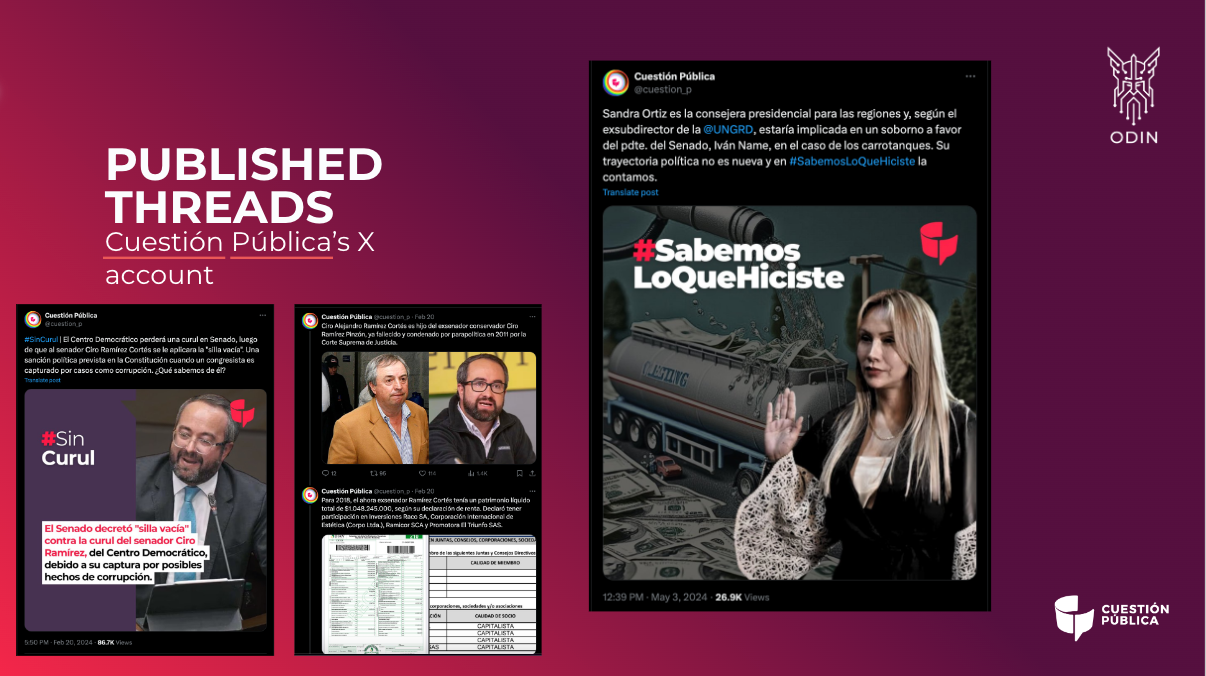How small Colombian investigative outlet Cuestión Pública is using AI to stay relevant on social media

Claudia Báez, founder of Cuestión Pública.
Cuestión Pública is a Colombian independent news site with a strong focus on investigating issues of public interest. It presents its investigations in a distinctive acidic tone, often side-by-side with cartoonish illustrations, and it has developed innovative ways to present its investigative work, such as through interactive games and apps.
Cuestión Pública is a small newsroom, with 10 full-time employees and a newsroom of 14 journalists, including those on a part-time or freelance basis. The company’s annual budget is $400,000, and 90% of its income comes from media development funds. Cuestión Pública has received grants from organisations such as the International Fund for Public Interest Media and is a member of the Organized Crime and Corruption Reporting Project (OCCRP).
In 2023, the outlet received a $5,000 grant from the Open Society Foundations’ Applied AI in Journalism Challenge to develop an idea for a practical application of AI in the newsroom. The outcome, known as Optimised Data Integration Network (Odín), is an AI-powered application that aims to tie Cuestión Pública’s investigative reporting to day-to-day breaking news.
I spoke to Claudia Báez, a co-founder and CEO of Cuestión Pública, who explained the project in her own words.
1. The project in a nutshell
Odín is an interface that takes advantage of the databases that Cuestión Pública built over the past five years. It is used to create threads for X that draw a connection between current breaking news events and relevant information Cuestión Pública unearthed through its investigations.
Odín creates the draft of the threads by drawing details from the database and evaluating which of the pieces of information relating to the person or organisation currently in the news is most relevant. Then, it puts together a draft in the distinctive tone and voice of the outlet. Journalists can then edit this thread as needed before posting it online. The threads are not labelled as having been produced with the help of AI. Examples of threads produced with Odín and edited by a journalist before publication cover topics like allegations of corruption and other crimes made against politicians.

2. The problem we wanted to solve
Claudia Báez: “Odín is a private interface created by Cuestión Pública to solve a problem. We are an investigative media outlet and that’s our main mission. But as an investigative outlet, we spend a lot of time doing investigations and miss the news agenda. By covering current events and daily news, we can be part of the news agenda and become more relevant to our audience.
When a politician is in the news and we have all this background about him or her, we can bring context to our audience by connecting current events with our investigative journalism. That's the kind of link Cuestión Publica makes. But our journalists are investigative journalists. We don’t have any daily reporters. So the solution to cover current events with investigative journalism is Odín.
If you save time to do these threads when the news is breaking, you gain a lot of relevance. But this kind of thread takes three hours for an investigative journalist to create. With Odin, it takes 15 minutes or less.”
3. The problems we encountered
C. B.: “One problem we faced was weighing the journalistic findings: how can that system establish the right priority for Cuestión Pública’s findings? Because we have so many findings! For example, if it's a member of Congress that we investigated in this section on legislative records, we would have many findings on assets, contracts, and networking. So Odín has to weigh the findings regarding the headline journalists already provided.
If the headline is something like, “The Supreme Court starts an investigation for corruption by a certain politician,” it could be that there are other instances of corruption related to that case. So Odín has to prioritise and say, this one is more important than this other one because it's more linked with the headline.
Odín puts on the voice of Cuestión Pública, the tone, and that's another difficult thing to do. Our style is acidic and ironic. It’s difficult to replicate. In the first prototype, Odín took around one minute to produce the output because we made the system complete three stages in a single chat with only one button, and that was slow.”
4. How we found a solution
C. B.: “To make Odín faster, we split it into three stages. Firstly you take all the findings and make Odín prioritise them according to the headline. In the second step, you find another button to create a draft for the thread. In the third, you get the draft with the right voice and tone.
We started with the methodology and a couple of examples and now we are fine-tuning the tool. Our seven-person data team gathered the output Odín was producing and started editing it. Then we fed Odín with 100 examples of these edited threads to fine-tune the voice of the tool. That’s where we are now.”
5. How the tool works in practice
C. B.: “We created a database of around 4,200 entities between people and companies in Colombia. Not just the names of the entities, but also a description we cross-referenced with many databases. Those 4,200 entities fit our two main applications. That is, ‘We know what you did during the last legislative period’ and ‘Game of Votes’ (Juego de Votos) [two interactive games based on the investigations Cuestión Pública produces]. So that's why we have semi-structured databases. And those are a really good asset because we can connect all that is happening in current events and trending topics, mainly on Twitter, with this information.
In journalism and media, you can use applications like Midjourney, ElevenLabs, or Perplexity. But the main thing that makes Odín different from other projects in AI and journalism is that Odín uses methodologies like fine-tuning and RaC [Rules as Code, the process of turning rules and policies into machine-readable code, so that they can be interpreted by computers]. This allows Odín to take the data Cuestión Pública creates, and create content with that context. While other applications have the context of the whole internet, we just put our own context in the interface.
To create the threads, journalists enter the interface. The first step is to add the headline. Journalists will see a social media trend and say, this person is being investigated right now, or somebody mentioned this person in this corruption scandal, and now they’re part of the news agenda.
Then, the journalists look for the name of the person or the company in a drop-down menu of our database, click on it, and click on another button to link the headline with that person that we already investigated.
Then Odín brings all the findings we had about this person and ponders which finding is more important to the context that the journalists provided in the headline.
In the fourth step, there is another button to create the draft of the thread with the findings. After this, the fifth and final step is another button, which adds the tone and style of our posts. In this step, the journalists can edit everything directly in the interface before copying and taking it out of the interface. Journalists can export the thread to Excel. Sometimes we add images or other visuals, but this is not automated.”
6. How the tool can be improved
C. B.: “One of the improvements we want to make is in the third step, when Odín brings out all the findings. We would like our tool to put in links because all this data, all our news apps have links in Excel, it’s Markdown syntax [a simple language for writing formatted text for the web which emphasises readability]. This is how it connects with the HTML on our web page. So, as they’re in Markdown syntax, if we can add them to the interface, we can optimise the time it takes to find the evidence that is going to be in the thread.
We want to develop the tool even further and let it create multi-format content: content for Instagram, videos, comics, everything. Not only for linking current events with investigative journalism but for any information that we already have on our website or our social media platforms.
Right now, we only have the database that we have built. But the thing that we want to do is to take everything, all the entities that Cuestión Pública has, not only on the website. Some information is only on social media, for example, but we have verified everything if Cuestión Pública publishes it.
Taking all this information, creating a new database, creating all the descriptions, verifying all this information, automatically matching any trending topics on social media with this old information, and sending notifications to the newsroom with a preview draft of the content we’ve created. We can save a lot of time doing that.”
7. How this can help other newsrooms
C. B.: “As an investigative media outlet, you should keep in mind that all your information is so valuable because it's like artisan work. You are not breaking news, you are not that kind of journalist. So, how can you take all this information, put it on a platform and make it more relevant?
You know the background of these people, you know why these people are in the news agenda because you are investigating them. So, how can a media outlet take all the information they’ve published for years and consolidate everything in one place, organise it and make it work for them? If media outlets don't take this technology seriously and put it to work for them right now, in 10 months it's going to be too late.
We want to monetise Odín, with all the improvements we want to make. Right now, it’s very customised [to Cuestión Pública]. If we find a way to scrape all the entities of a media outlet with descriptions, a tool like Odín can start to make independent media outlets visible in the news agenda. Currently, we are seeking funding to evolve the tool into a model that can be used by other media companies that do not have Cuestión Pública's capabilities.
We are a small newsroom, and we have an audience interested in this kind of information, but we are not reaching regular citizens. Our information is not picked up by the mainstream media. If you’re in this situation, you need to start to make different formats for different audiences. AI can impact independent news outlets if we know how to use the technology.”
Find out more:
- Odín and other projects from the Applied AI in Journalism Challenge were presented at the International Journalism Festival in Perugia in April. | Check out our coverage
- David Caswell, lead consultant and mentor for the Applied AI in Journalism Challenge, also authored an essay on AI and journalism for us in September. | Read it here
- We’ve published more case studies, journalistic pieces and research reports around AI. | Explore our work on AI and the future of news
In every email we send you'll find original reporting, evidence-based insights, online seminars and readings curated from 100s of sources - all in 5 minutes.
- Twice a week
- More than 20,000 people receive it
- Unsubscribe any time
signup block
In every email we send you'll find original reporting, evidence-based insights, online seminars and readings curated from 100s of sources - all in 5 minutes.
- Twice a week
- More than 20,000 people receive it
- Unsubscribe any time




